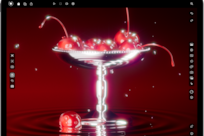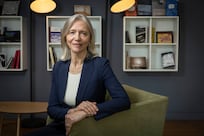When the artist Elizabeth Dorazio sat with Emirati khoos palm-frond weavers, she heard "music" in the craft. It was a few years ago; she had just moved to the UAE and was exploring the country.
“I was trying to understand the place I was now in,” says the artist, who is originally from Brazil. “I came across the women’s union at the handicraft centre in Abu Dhabi. I was fascinated by al khoos. You sit in a group and the women talk about life and history, and they say, ‘tell me about your family, your history, your problems’. It is a universal situation. I saw this as music. I connected with the movement from the spirals and the movement of the hands: it was music coming from there.”
Circular themes
Dorazio's current exhibition at the New York University Abu Dhabi Project Space, Symphoniae, is the fruit of that encounter: she paired the circular rush mats, from the women in the union, with paintings of the stars and the desert, as well as elements from her native country. The works are all circular, and she stitched them to the rush mats so that she formed multitudes of circles, as if galaxies moving towards an eclipse. A sculpture in the middle of the room emits a low hum.
“I started painting inspired by the feelings I was getting through the spirals,” she says. “I imagined human histories, private lives, even much earlier histories: palm tree groves, the way they used the mats, stories from ancient books and manuscripts.”

Each of the works is “baptised”, she says, in the name of a different constellation, reflecting the importance of stars and natural elements in guiding the Bedouin tribespeople before modernity.
"The ancient Bedouins were following stars, and the Ursa Major is here on top," she says, pointing to a drawing of the constellation in the work Ursae Majoris. Nearby, within the same work, is a painting of a repeated, wave-like pattern made in sand that the Bedouin used to read the elements. "They were travelling guided by the wind. The wind moves the sand and makes drawings in the sand."
'Nature has no angles'
Many of the items that she included from Brazil also speak of travel, albeit of a different kind: they are items brought over during the slave trade from Africa, such as the baobab tree or magic symbols, which have become part of Brazilian culture.

In the centre of the gallery is the sculpture Space and Time: a small pile of brown and black volcanic stones on top of which is placed a megaphone made out of two transparent plastic cones. From it comes a low, comforting hum – a piece of electronic music Dorazio had commissioned from a friend in Stockholm to suggest the way "the universe, the planets, all of us are always moving". Above it, painted black, is a collection of circular mats, representing the cosmos.
The circle, the key form in this exhibition, has been integral to Dorazio’s work before, again for its connection to nature. “For me, the circle is the perfect shape,” she says. “I believe that nature has no angles. Nothing straight. No corners.”
For previous pieces, she cut different-sized circles out of coloured plastic, playing with more formal questions of transparency and colour in assemblages that resemble those in Symphoniae.
The final verdict
It would have been nice to see these here: because of the use of khoos rush mats, this show is in danger of being read as a project solely about heritage and craft, rather than its more expansive thesis of the interconnectedness of human life. And the insight of the "sound" of the khoos mats gets lost: although this is gestured at in the vibrations of Space and Time, which fills the room with its hum, the connection between the khoos assemblages and the sound they might make remained unclear.
_______________________
Read more
This Dubai gallery has turned its commercial failure into art
Artists investigate public entertainment in Pakistan and Saudi Arabia
Discovering 150 years of library architecture at the Venice Biennale
_______________________
But Dorazio's literal stitching together of new stories for the khoos fronds shows how travel, culture and nature form a constant alliance, in instances historical – the star-gazing Bedouin in the Arabian Peninsula or the baobab-planing Africans in Brazil – and current, such as the immigration of different nationalities to the UAE and the different ways they use Emirati traditions and natural flora. Dorazio grew up in a small town amid farms and coffee plantations: "We were always running and playing and climbing," she says. "I still have that strong connection with nature." Here, amid stories of culture and travel, it comes to the forefront.
Elizabeth Dorazio’s Symphoniae is at the NYUAD Project Space until June 23.






